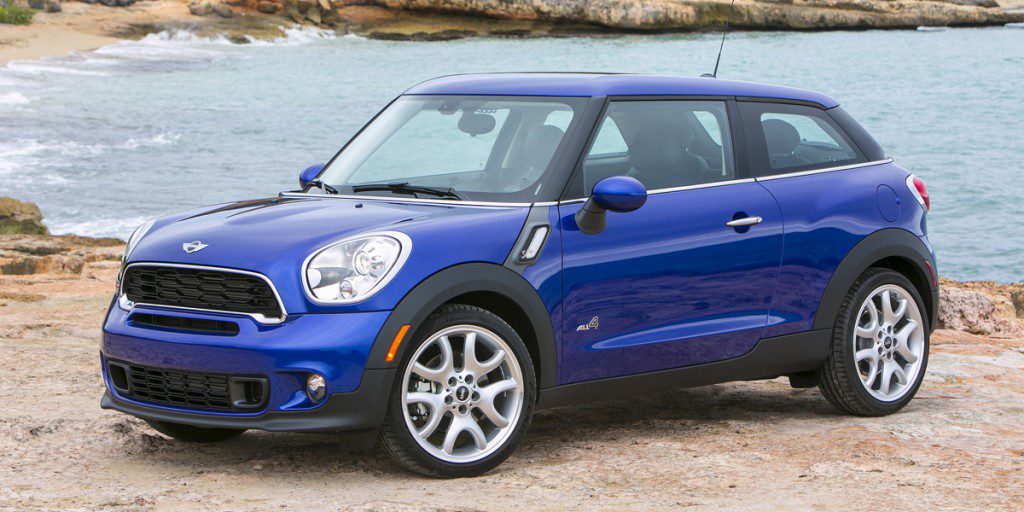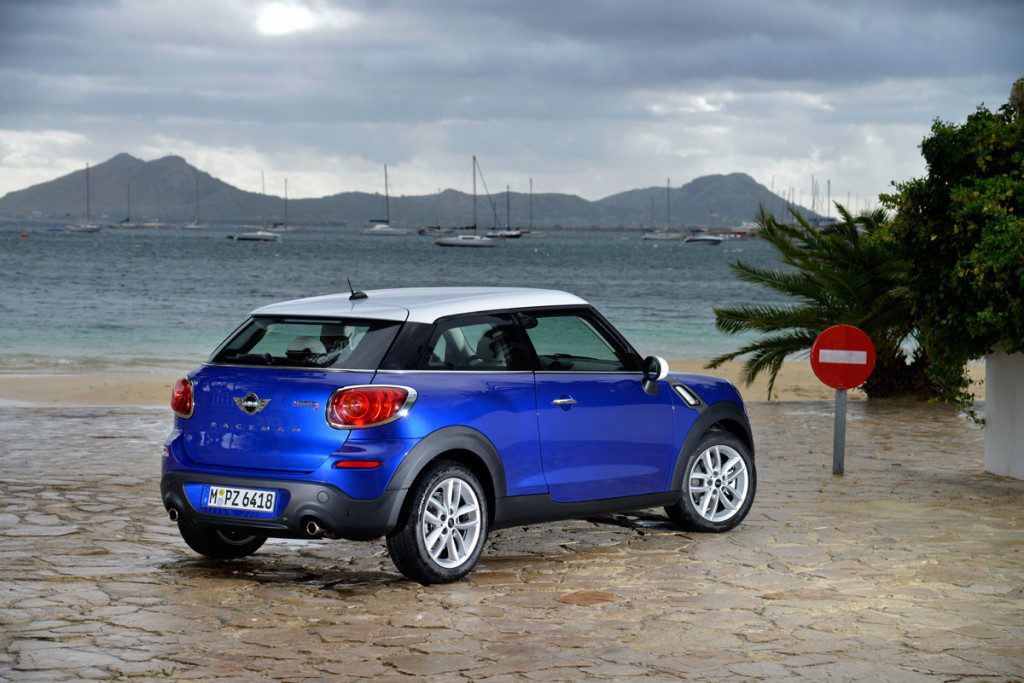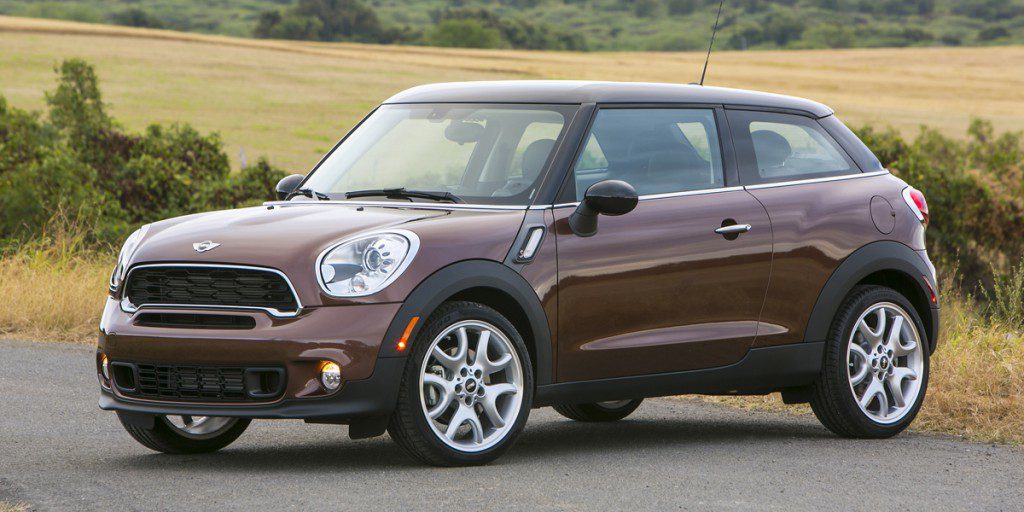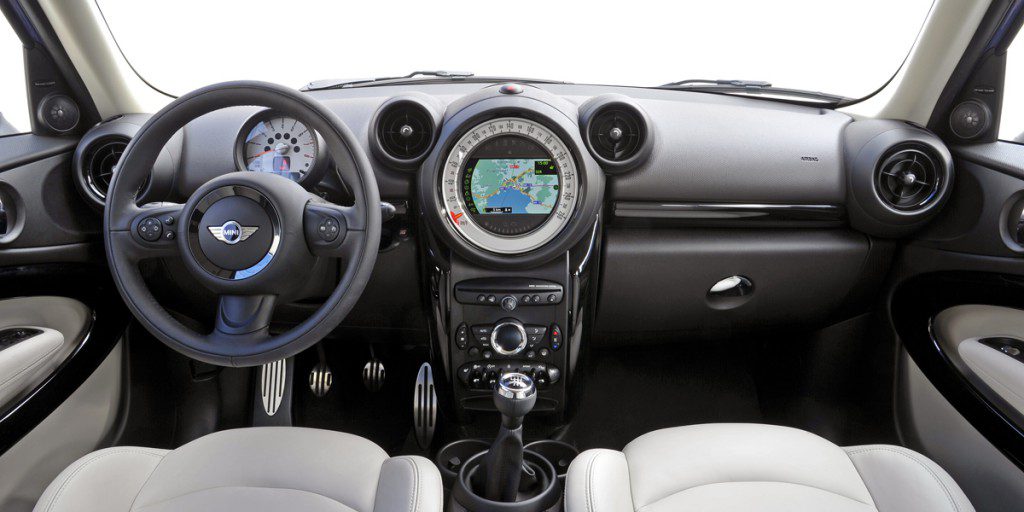| Compact SUV; Built in |
|
|
| Good condition price range: $13,000 – $32,100* |

2014 Mini Cooper S Paceman ALL4

2014 Mini Cooper S Paceman

2014 Mini Cooper S Paceman

2014 Mini Cooper S Paceman
| Pros: |
|
| Cons: |
|
The Cooper Paceman is a unique vehicle because it has the qualities of an SUV (relatively high ride height, a wagon body style, and the availability of all-wheel drive), but only two doors. Most of its competitors are compact SUVs, all of which have the functionality of four doors and generally more overall interior space. But Paceman is marginally quieter and smoother riding than the similar Mini Cooper Countryman, which has four doors. For some buyers, the Paceman’s unique 2-door styling will outweigh the corresponding compromises in practicality, but most buyers will probably find the Countryman a more logical choice.
Overview
The Mini Cooper Paceman arrived for 2013 as the second SUV and the seventh discrete model from this BMW-owned British brand. It was basically a 2-door version of the 4-door Cooper Countryman compact crossover, but with sportier styling and less off-road flavoring. Mini termed Paceman a “sports activity coupe” for “cutting a swathe through the urban jungle.”
The Paceman shared the Countryman’s choice of front-drive and available “ALL4” all-wheel drive, as well as powertrains and most other features. It was fractionally longer than the Countryman, stood about an inch lower, and had a sloping roofline instead of a level surface. Paceman was otherwise dimensionally close to the Countryman, but sat four only, rather than five as standard.
As one of the few 2-door SUVs on the U.S. market, the Paceman had little direct competition. Though the Kia Soul and Nissan Juke were arguably closest in character and price among mass-market brands, some saw the Paceman as a rival for the premium-class Land Rover Range Rover Evoque.
Like the Countryman, the 2013 Mini Cooper Paceman was offered in four versions: front-wheel-drive base and S, and all-wheel-drive S ALL4 and John Cooper Works (JCW). Mini said all models included a sport suspension with a lower ride height versus Countryman. Run-flat tires on alloy wheels were also standard across-the-board, with 16-inch rims for base models and 17s for all S versions. The JCW received 18-inch wheels and offered 19s at extra cost.
The 2013 Mini Cooper Paceman was sold only as a 4-passenger vehicle with sport front bucket seats and individual rear seats. Paceman’s rear seats slid fore/aft up to five inches to balance passenger and cargo space; they could also fold to expand the rear load deck. In addition, all Paceman models came with the center-rail storage system that was optional for Countryman. This involved specially designed “utensils”–sunglasses case, cellphone cradle, extra cupholders, etc.–that could be clipped to metal guides between each pair of seats. A full-length rail was optional.
Other base-model features were more or less the same as for the entry-level Countryman. That meant vinyl upholstery, a leather-wrapped tilt/telescopic steering with audio and cruise controls, a steering-column-mount tachometer, remote power door locks, a cooled glovebox, and an AM/FM/CD stereo with HD radio tuner, Bluetooth connectivity, and media-player plug-in.
Paceman S and S ALL4 added front fog lights and special trim. Additional standards for the John Cooper Works included upgraded brakes, limited-slip differential and unique JCW trim.
Like Countryman and all other Mini Coopers, the Paceman offered numerous options, with many major items available both separately and in packages. The Paceman was available with a Countryman-like selection of Premium, Sport, Technology, and Cold Weather Packages. These encompassed such features as automatic climate control, keyless access/engine-start, rear-obstacle detection, rain-sensing wipers, heated front seats and door mirrors, and a “sport” traction-control system that could be fully disabled at the driver’s discretion.
Among the most notable standalone options were a panoramic sunroof, steering-linked xenon headlamps, premium harmon/kardon audio, and a navigation system with Mini Connected. The last was an infotainment/vehicle-systems control interface than could also be used with data-plan-enabled smartphones and downloadable apps. Once the phone was configured and paired with the car, Mini Connected could access streaming Internet radio, RSS news feeds, Facebook, Twitter, and other online resources.
Like other Mini Coopers, the Paceman offered a wide array of “personal” trim and color options. These included various cabin-accent materials, additional chrome trim, racing stripes, and bold body graphics. Buyers could also specify larger-than-standard tires and different wheel designs.
Like other Mini Coopers, the Paceman used a 1.6-liter 4-cylinder engine with direct fuel injection and tuning specific to each model. The base version produced 121 horsepower, while the S and JCW engines added a turbocharger to achieve 181 and 208 horsepower, respectively. Both turbo engines included an “overboost” feature that provided extra power in brief bursts under certain operating conditions. All models offered a 6-speed manual transmission or an optional 6-speed torque-converter automatic with manual-shift feature and, base model excepted, steering-wheel shift paddles.
As noted, the Cooper and Cooper S were front-wheel drive, while the Cooper S ALL4 and JCW had standard all-wheel drive. As on the Countryman, the AWD used an electronically controlled center differential for apportioning power between the axles. The system normally provided a 50/50 front/rear split, but could direct up to 100 percent power to either axle in extreme conditions.
EPA fuel-economy ratings for the 2013 Mini Cooper Paceman were 27 mpg city and 35 mpg highway for the base mode with manual transmission. The optional automatic lowered those ratings to 25/30. The S was rated at 26/32 with the manual and 25/32 with automatic. The S ALL4 and JCW ALL4 models were rated at 25/31 with the manual and 23/30 with automatic. All used premium-grade gas.
The 2013 Mini Cooper Paceman came with expected and federally required safety features including antilock brakes (ABS), stability system, and traction control, plus front and curtain side airbags and a front-passenger knee airbag. Rear side airbags were not offered. The available all-wheel drive and standard run-flat tires could be regarded as safety-related enhancements along with the manual transmission’s hill-holder clutch.
Yearly Updates
| 2013 Cooper Paceman There were only minor changes for the 2014 Paceman. Heated side mirrors and washer jets were now standard, and there were optional John Cooper Works appearance packages. |
